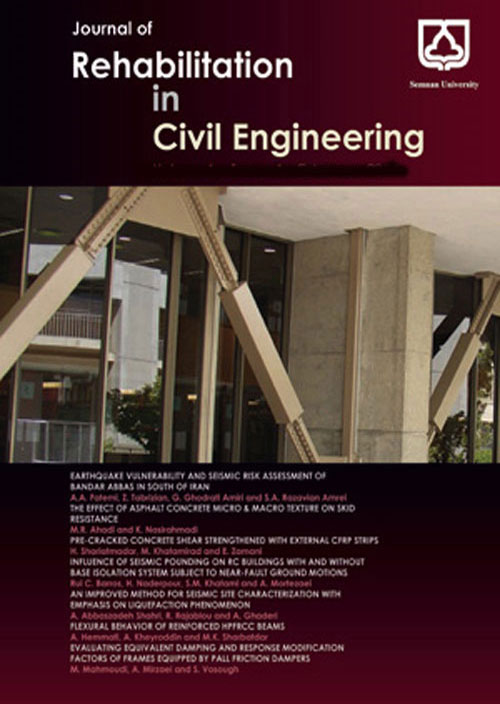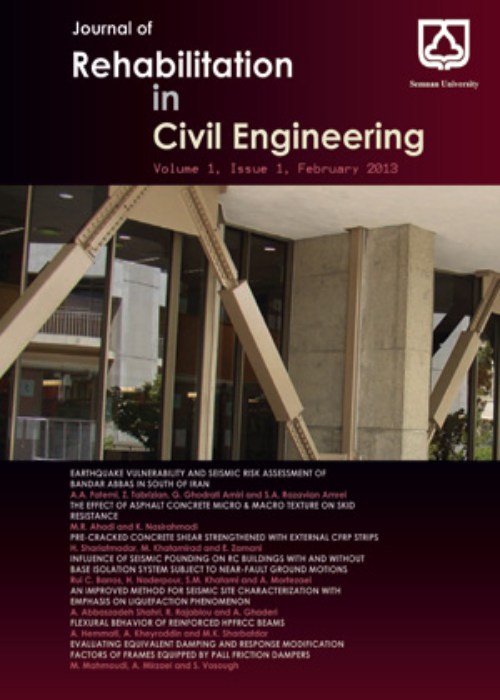فهرست مطالب

Journal of Rehabilitation in Civil Engineering
Volume:9 Issue: 2, Spring 2021
- تاریخ انتشار: 1400/05/10
- تعداد عناوین: 8
-
-
Pages 1-20Dealing with the pollution released into the air by vehicles is a major concern for many countries around the world. There is an increasing trend toward environmental considerations as well as road logistics issues, resulting in doing experiments on new materials, which can help reducing the amount of pollutants in the atmosphere. In this research, the photo catalytic properties of Nano TiO2/SiO2 used over the asphalt roads in order to absorb the pollution substances from the atmosphere are investigated. The above mentioned compound reacts with UV light and oxidizes the pollutant particles including nitrogen oxides (NOx) as well as volatile organic compounds (VOC). In this method, the sol-gel technique was used to produce photo catalyst based on TiO2/SiO2. One purpose of this research is to examine the photo catalytic properties of the compound when it is used in a hot mix asphalt (HMA). Another aim of the study is to find and describe both rheological and mechanical characteristics of the hot mix asphalt (HMA) as well as the Nano modified agents. The resulting asphalt would have the advantages of HMA, including lower energy requirements and less emission during production, while having photo catalytic characteristics of TiO2/SiO2 to absorb and decompose the organic and inorganic air pollutants. The outcomes of the tests showed that adding the Nano TiO2/SiO2 modifier to the asphalt binder effectively removed NOx particles from the air and enhanced the rheological properties of bitumen. It also enhanced the hardness and viscosity of the pavement, while reducing its penetration and fatigue life. When TiO2/SiO2 was sprayed as a water based coating, the efficiency of NOx reduction ranged between 41 and 63%.Keywords: Asphalt Mixture, Modified bitumen, Nano materials, Air pollution, Fatigue life
-
Pages 21-40The occurred earthquakes in recent years have proved that in some parts of the world, they possess more duration and cause further damage to structures. Due to the fact that major cities of Iran are located in the high seismic areas and also a significant part of existing buildings are concrete structures, it is necessary to study their vulnerability under long duration earthquakes. In this study, the performance of concrete structures affected by earthquakes with different durations (from low to high) has been investigated. In order to investigate the duration of the earthquake, a new index is defined, which is the number of accelerated cycles where their period is close to the structure predominant periods (with 10% difference) and their corresponding acceleration is also higher than the plastic acceleration threshold of the structure. For this purpose, three concrete structures with, 3, 6, and 9 stories were designed with optimal sections and the predominant period and the threshold acceleration for entering nonlinear behavior were calculated. Subsequently, all three buildings were investigated in two-dimensional SeismoStruct software and nonlinear analysis was carried out considering the stiffness deterioration and strength reduction (Takeda model). Each of the 3, 6 and 9 story structures was subjected to 119 earthquake records, durations, distances, magnitudes, and different soil types. Seismic performance of structures such as relative maximum displacement and number of plastic joints were investigated. The results of the analysis show that the use of the index introduced in this study is much more efficient than other definitions of duration for damage to concrete structures. In other words, duration of an earthquake, as defined by the number of cycles whose period is near the predominant period of the structure and accelerated beyond the plastic acceleration threshold of the structure, is very consistent with the rate of damage to the concrete structure. In continuation, the effects of the height and plastic acceleration threshold on various models are discussed in detail.Keywords: Earthquake duration, concrete structure, number of effective cycles, Plastic threshold acceleration threshold, stiffness deterioration, strength reduction
-
Pages 41-54
In spite of many benefits, FRP materials are susceptible to elevated temperatures. On the other hand, because FRP laminates are different from other FRP materials, data acquired from investigations concerning FRP materials cannot be suggested for FRP laminates. An assessment of the tensile performance of fibers impregnated by epoxy resin as binder is needed. In recent decades, many methods have been presented to protect fiber reinforced polymer (FRP) composites against high temperatures. The application of fire protection mortar is a low-cost and easy technique among all methods. In this investigation, the influence of fire protection mortar on the improvement of the tensile strength of glass fiber reinforced polymer (GFRP) and carbon fiber reinforced polymer (CFRP) laminates was evaluated. For this object, over 200 FRP laminates with or without fire protection mortar were tested at various elevated temperatures. Investigated temperatures varied from 25°C to 500°C. According to the results obtained from this study, the strength of FRP laminates considerably reduced following the laminates experienced the temperatures higher than 400°C. However, the samples covered with fire protection mortar underwent lower the tensile strength decrements. Eventually, a linear model was presented to estimate the strength of FRP laminates including or excluding protective mortar at elevated temperatures on the basis of linear regressions carried out on test data.
Keywords: FRP laminates, Fire protection mortar, Elevated temperatures, Linear regression model -
Pages 55-70One of the most important structural features is fundamental vibration period which depends significantly on the inherent characteristics of structures. Seismic codes and some researchers estimate experimentally and mathematically fundamental vibration period using the number of stories or the overall height of the building. The consequences of evaluating the various relationships have been resulted based on structural height, mass, stiffness and number of stories. As the overall height and the number of stories do not make difference between regular and irregular structures, so it seems that mass and stiffness of each story is so important in zone of building vibration period. Considering the importance of irregular buildings, a new relationship proposed to determine fundamental natural period of vibration for elastic regular and irregular buildings in height using artificial neural network. The accuracy of the proposed relationship is perfectly validated and confirmed by numerical calibrations and matrix analyses.Keywords: fundamental natural period, irregular building, Artificial Neural Network, Drift
-
Pages 71-84
The risk management standard published by the Project Management Institute (PMI), entitled Project Management Body of Knowledge (PMBOK), was utilized in the present study as the primary method for evaluation of risk management. The general purpose of this article is to prioritize risk in water and wastewater projects through the analytic hierarchy process (AHP). The statistical population considered here covers all the factors involved in water and sewage projects. Sample size determination was done based on the Morgan table, which resulted in selecting 59 high-expertise experts. The Delphi method, a process used to arrive at a group opinion or decision by surveying a panel of experts, was used for risk identification. After entering the raw data into an Expert Choice program, based on the AHP decision model, data analysis was completed. The obtained results indicate that budget deficit is the most critical risk factor of the project, preceding by inflation and international sanctions. Furthermore, risk factors related to expanding the project relationship with other areas, the area's religious location, and the area's environmental hazards, and the project site are the least important ranking items.
Keywords: Risk Management, Decision making, Water, sewage project, AHP -
Pages 85-100Many concrete structures need rehabilitation during their service life for different reasons; poor quality of construction, relatively lower compressive strength of concrete, non-compliance with existing or updated design codes, and buildings that experienced an intensive earthquake are to name but a few. One of the solutions to strengthen concrete structures is to install rebar inside the structural components. In this paper, the effect of steel rebar planting with a constant nominal diameter of 8 mm along with two different lengths (i.e., 35 and 55 mm) as well as two different planting angles (i.e., 0 and 45 degrees) have considered as variables. Therefore, the rebar planting process has conducted on 12 low-strength cylindrical concrete specimens with an initial compressive strength of 15.5 MPa. The concrete column specimens were tested under uniaxial compressive load after rebar planting. The results of this study indicated that rebar planting leads to an increase in the initial compressive strength of the concrete specimens in general. The specimens with 35 mm and 55 mm planted length witnessed an average enhancement of 17% and 23%, respectively. Moreover, considering the angle of planted rebar as another variable parameter, the obtained results revealed that the maximum compressive load for both 35 mm and 55 mm specimens with a planting angle of 0-degree and 45-degree almost followed the same increase and improved by an average of 5%.Keywords: Rehabilitation, concrete structure, Low strength concrete, Compressive Strength, Steel bar, rebar planting
-
Pages 101-119Seismicity zoning was conducted for different areas of Iran due to general zoning in relative regulations. For increasing reliability in achieving desired safety margin and select a carefully basic acceleration of plan due to the sensitivity of the subject and usage of this parameter in the calculation of the basic shear and control on stability of the construction components, on the other hand, It is essential to zoning more accurate and partially. In this paper, in order to preparation of same acceleration maps of both the horizontal and the vertical component of the acceleration as a case study in the city of Sabzevar in Iran, the seismic springs identified and seismic parameters of the area extracted. According to attenuation relationships and the proper reasonable tree, probabilistic seismic hazard analysis was conducted. The effect of the vertical component was also applied. Two soil type has been selected for review. The first type of soil based on soil type I, II and second type of soil based on soil type III, IV of soil classification based on Iran’s standard No. 2800. After doing the analysis of same acceleration maps according to different design levels with a return period of 475, 225, 72 and 2475 and based on seismic improvement buildings instruction in 50 years of useful life and two types of soil were calculated and plotted. Also, the results of the analysis of the potential risk of seismic with the results for the study zoning area Iran’s standard No. 2800 were compared.Keywords: PSHA-Probabilistic Seismic Hazard Analysis, Probabilistic, Improvement, Danger levels, SeisRiskIII
-
Pages 120-145
Sulfate attack reduces the service life of concrete structures, which isn't possible to repair simply. Implementation of many factors influencing the sulfate resistance, sample scaling, and results in the least possible time is some problems of experimental studies. Therefore, numerical simulations, as well as the new methods along with experimental studies, have been led to better evaluation of sulfate attack within a shorter time and at a lower cost. In the present study, the effective factors, causes, and mechanisms of sulfate attack, examples of this phenomenon in real projects, and the previous studies in this regard, in particular, the development of the thermodynamic study of cement under sulfate attack as a fast and inexpensive solution have been reviewed. The present investigation is divided into three parts, first the sulfate attack mechanism, second the factors influencing phases containing sulfate formation, and third a review of the methods and results of the studies, focusing on the development of thermodynamic models in cement sulfate attack especially. Finally, the results of the studies show that common experimental methods related to concrete sulfate resistance evaluation can't always simulate what is actually happening; subsequently, the results of experimental studies and real cases are sometimes different. So, numerical models, in particular, thermodynamic simulation, either alone or in combination with experimental studies, can be a desirable solution for enhancing the ability to predict engineering behavior of concrete structures in the sulfate environment. Subsequently, it results in making better decisions to tackle and prevent deterioration caused by sulfate attack.
Keywords: Sulfate attack, Concrete durability, Experimental studies, Numerical studies, Thermodynamic simulation


